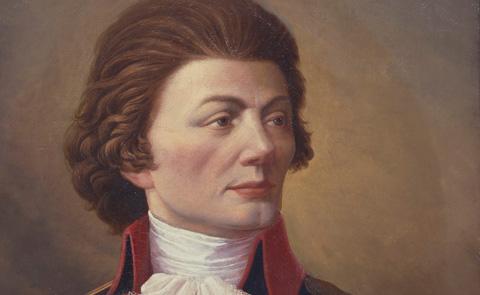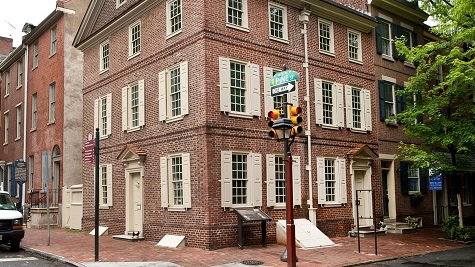Thaddeus Kosciuszko National Memorial

"As pure a son of liberty as I have ever known"
- Thomas Jefferson on Thaddeus Kosciuszko .
On August 18, 1797, throngs of Philadelphians lined the wharves to welcome a Polish-born Revolutionary War hero back to the United States. The mob carried him on their shoulders while bands played and cannons fired fusillades of homage. The object of this adoration, Polish-born engineering genius, Thaddeus Kosciuszko (KOS-CHOOS-KO), was called by Thomas Jefferson, "as pure a son of liberty as I have ever known."
Born into chapfallen gentry, in the Polish province of Polesie on February 4, 1746, Tadeusz Andrzej Bonawentura Kosciuszko went on to study military engineering in Paris. Like many Europeans of his time, the handsome Polish student became captivated with the Revolutionary activity in the New World. He volunteered to join the ragtag rebels shortly after the given a salary of $60 a month. His first undertaking was planning forts along the Delaware River. Kosciuszko then moved on to help with the defense of Fort Ticonderoga. Partly due to disregard of Kosciuszko's advice, Ticonderoga was toppled; in retreat Kosciuszko felled great pine trees and flooded fields to slow the pursuit of the British. This bought the rebels time to prepare for their first major victory of the war: Saratoga. At Saratoga, Kosciuszko fortified Bemis Heights overlooking the Hudson. His ingenious design contributed to the surrender of 6,000 troops under General John Burgoyne. After the British defeat outside of Saratoga, the French entered the war on the colonials' side.
Kosciuszko then undertook the defense of the Hudson at West Point. So thorough were the Pole's fortifications, that the British never mounted an assault on the Point. One of the more imaginative links in the colonel's defensive plan, proved to be a 60 ton chain which stretched across the Hudson to block British ships. Kosciuszko went on to lead troops. At war's end, he was promoted to Brigadier General and received Congressional recognition honoring his "meritorious service."

The Thaddeus Kosciuszko National Memorial is operated by the Park Service and is open to the public free of charge. Check their website for hours and tourism information.
Following the war, Kosciuszko returned to his homeland to fight the occupying Russians. After being wounded 17 times during the battle of Maciejowice in 1794, the bleeding Kosciuszko was taken prisoner by the Russians. After two years in prison, Czar Paul granted the Pole amnesty on the condition he never return to his homeland.
The ailing military man set off once more to America with a twofold purpose: to consult Dr. Benjamin Rush concerning his war wounds and to collect pay still owed him for his military service. The aforementioned mob carried him to the boarding house of Mrs. Lawson. He found his lodging there unacceptable. It was too expensive and according to journal accounts from Moreau de St. Mery, street walkers made the neighborhood distasteful: "They fulfill every desire for two dollars, half of which is supposed to pay for use of the room."
Further, Yellow Fever was again ravaging Philadelphia. To escape the contagion, Kosciuszko visited old friends, including General Horatio Gates in New York. Upon his return to Philadelphia, Kosciuszko moved to the humble boarding house run by Mrs. Ann Relf. Here the feted Kosciuszko convalesced while receiving admirers daily. Vice President Jefferson came by frequently for political parley. Philadelphia ladies, taken by the handsome hero, had their pictures sketched by Kosciuszko himself. Those who visited make up a veritable Who's Who of the capital in 1798: eminent architect Benjamin Latrobe, Joseph Pemberton, Constitutional Convention statesman William Paterson, and numerous military figures including Chief Joseph Brant. Perhaps the most compelling visitor to call upon Kosciuszko was Chief Little Turtle of the Miamis. In the capital to negotiate a border settlement with the government, Little Turtle had a memorable gift exchange with Kosciuszko. The chief gave the Polish warrior a combination tomahawk and pipe and in return Kosciuszko gave Little Turtle a fine jacket and his spectacles which were admired by the chief. Little Turtle was an early advocate of banning the sale of alcohol to native Americans and for government assistance in aiding tribes. Kosciuszko was awarded $12,260.54 back pay from Congress which with interest amounted to $15,227.87. In addition, Congress gave him 500 acres of land along the Scioto River in what is present-day Columbus, Ohio.
Restive and yearning for Poland, Kosciuszko left the States in 1798 but never made it back to his homeland. He died in exile in Switzerland in 1817.
- Land once owned by Jacob Duche who was head of the Episcopal Church in the colonies.
- It is believed that John Nixon (the first man to read the Declaration of Independence publicly) was born on the site, though not at this house.
- Edward Piszeck, the founder of Mrs. Paul's seafood donated the building to the National Park Service in the early 1970's.
- Location: Corner of 3rd and Pine (Map)
- Built: 1775-76
- Architect: Joseph few, member Carpenters' Company
- Style: Georgian
- Commissioned by: Joseph Few
- Tourism information: Open April - October. Closed November - March. / (215) 965-2305
- Facilities: Bathrooms; some books for sale; 7-minute movie; tours provided upon request



